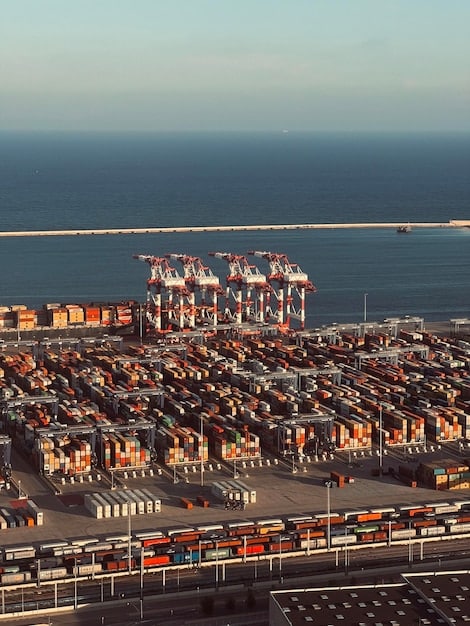Supply Chain Disruptions: Strategies US Companies Use to Mitigate Risks

US companies are employing a range of strategies, including diversifying suppliers, increasing inventory levels, and leveraging technology, to mitigate the increasingly frequent and severe supply chain disruptions in today’s volatile market.
In today’s interconnected global economy, supply chain disruptions: What strategies are US companies using to mitigate risks in the current market? This is a question on the minds of CEOs and supply chain managers across the nation as they navigate unprecedented challenges.
Understanding the Landscape of Supply Chain Disruptions
The term “supply chain disruption” has become increasingly common in recent years. But what does it truly encompass and why is it so critical for US companies to address?
A disruption can range from a minor delay in receiving raw materials to a complete shutdown of production lines due to unforeseen circumstances. These events can severely impact a company’s ability to meet customer demand, leading to lost revenue, damaged reputation, and a weakened competitive position.
Common Causes of Supply Chain Disruptions
Several factors contribute to the growing frequency and severity of supply chain disruptions. These include:
- Geopolitical Instability: Trade wars, political unrest, and international conflicts can disrupt the flow of goods across borders.
- Natural Disasters: Hurricanes, earthquakes, floods, and other natural disasters can damage infrastructure and interrupt production.
- Cyberattacks: Cyberattacks targeting supply chain networks can cripple operations and compromise sensitive data.
- Pandemics: As the COVID-19 pandemic showed, outbreaks of infectious diseases can cause widespread disruptions to manufacturing, transportation, and logistics.
US companies are particularly vulnerable to these disruptions due to their reliance on global supply chains. The increasing complexity and interconnectedness of these chains make them more susceptible to cascading failures.
In conclusion, understanding the landscape of supply chain disruptions requires recognizing the diverse range of potential causes and their far-reaching consequences. For US companies, proactive mitigation strategies are no longer a luxury but a necessity for survival and success.
Diversifying the Supplier Base
One of the most effective strategies for mitigating supply chain risks is diversifying the supplier base. This involves sourcing materials and components from multiple suppliers, rather than relying on a single source.
By diversifying, companies can reduce their dependence on any one supplier and minimize the impact of a disruption affecting that supplier. This approach provides greater flexibility and resilience in the face of unforeseen events.
Benefits of Supplier Diversification
Diversifying the supplier base offers several key benefits:
- Reduced Reliance on Single Sources: Spreading procurement across multiple suppliers minimizes vulnerability to individual supplier issues.
- Increased Price Negotiation Power: Having multiple options allows companies to negotiate more favorable terms with suppliers.
- Access to Innovation and Expertise: Working with a diverse set of suppliers can expose companies to new technologies, processes, and ideas.

However, diversifying the supplier base also requires careful planning and execution. Companies need to thoroughly vet potential suppliers, assess their capabilities, and establish strong relationships to ensure quality and reliability.
In conclusion, diversifying the supplier base is a critical strategy for US companies seeking to enhance their supply chain resilience. While it requires a strategic and proactive approach, the benefits of reduced risk and increased flexibility are well worth the effort.
The Role of Strategic Inventory Management
Maintaining adequate inventory levels is another crucial strategy for mitigating supply chain disruptions. This involves balancing the costs of holding inventory with the need to ensure sufficient supply to meet customer demand.
While lean inventory management has been popular in recent years, the current environment of frequent disruptions requires a more strategic approach. Companies need to carefully assess their risk tolerance and adjust inventory levels accordingly.
Key Considerations for Inventory Management
Strategic inventory management involves several key considerations:
- Demand Forecasting: Accurate demand forecasting is essential for determining appropriate inventory levels.
- Lead Time Analysis: Understanding the lead times for different suppliers is crucial for planning inventory replenishment.
- Safety Stock Levels: Maintaining safety stock provides a buffer against unexpected demand surges or supply delays.
Companies can also leverage technology to improve inventory management. Advanced planning and scheduling (APS) systems can help optimize inventory levels and ensure timely replenishment.
Effective inventory management requires a collaborative approach involving all stakeholders in the supply chain, from suppliers to customers. By sharing information and coordinating efforts, companies can improve visibility and responsiveness.
In conclusion, strategic inventory management plays a vital role in mitigating supply chain disruptions. By carefully balancing costs and risks, US companies can ensure they have the right amount of inventory to meet customer demand without incurring excessive holding costs.
Leveraging Technology for Supply Chain Visibility
Technology plays a crucial role in enhancing supply chain visibility and enabling companies to respond quickly to disruptions. Real-time data and analytics provide valuable insights into the flow of goods and materials, allowing companies to identify potential bottlenecks and take corrective action.
Investing in technology is no longer a luxury, but a strategic imperative for US companies seeking to build resilient supply chains.
Technological Solutions for Supply Chain Management
Several technological solutions can improve supply chain visibility:
- Blockchain Technology: Enhances transparency and traceability throughout the supply chain.
- Internet of Things (IoT): Provides real-time data on the location and condition of goods in transit.
- Artificial Intelligence (AI): Enables predictive analytics for identifying potential disruptions and optimizing logistics.
Companies can also use cloud-based platforms to connect with suppliers and customers, facilitating seamless information sharing and collaboration. These platforms provide a centralized view of the supply chain, enabling stakeholders to make informed decisions.

However, implementing these technologies requires careful planning and integration with existing systems. Companies need to ensure they have the right infrastructure and expertise to effectively leverage these tools.
In conclusion, leveraging technology is essential for US companies seeking to improve supply chain visibility and resilience. By investing in the right technologies, companies can gain a competitive advantage and mitigate the impact of disruptions.
Building Strong Supplier Relationships
Establishing strong relationships with suppliers is a critical component of supply chain risk mitigation. These relationships are built on trust, transparency, and collaboration, enabling companies to work together to overcome challenges and ensure the smooth flow of goods and materials.
While transactional relationships may be sufficient in stable times, the current environment of frequent disruptions requires a more strategic and collaborative approach.
Elements of Strong Supplier Relationships
Building strong supplier relationships involves several key elements:
- Open Communication: Regular and transparent communication is essential for building trust and resolving issues quickly.
- Collaborative Planning: Working together with suppliers to develop forecasts and plan production can improve responsiveness and reduce waste.
- Shared Risk and Reward: Aligning incentives and sharing both the risks and rewards of the supply chain can foster a sense of partnership.
Companies can also invest in supplier development programs to help their suppliers improve their capabilities and performance. This can include providing training, technical assistance, and financial support.
Strong supplier relationships provide a valuable source of resilience in the face of disruptions. By working together, companies and their suppliers can find creative solutions and minimize the impact of unforeseen events.
In conclusion, building strong supplier relationships is a critical strategy for US companies seeking to mitigate supply chain risks. These relationships provide a foundation of trust, transparency, and collaboration that enables companies to respond effectively to disruptions and ensure the continuity of their operations.
Nearshoring and Reshoring Initiatives
In response to increasing global supply chain disruptions, many US companies are considering nearshoring and reshoring initiatives. These strategies involve relocating production closer to the United States, either to neighboring countries like Mexico and Canada (nearshoring) or back to the United States itself (reshoring).
These initiatives can reduce reliance on distant suppliers and shorten transportation times, making supply chains more agile and responsive.
Advantages of Nearshoring and Reshoring
Nearshoring and reshoring offer several potential advantages:
- Reduced Transportation Costs and Lead Times: Bringing production closer reduces transportation costs and shortens lead times, improving responsiveness to customer demand.
- Improved Communication and Collaboration: Working with suppliers in closer proximity facilitates communication and collaboration.
- Enhanced Intellectual Property Protection: Producing goods in countries with strong intellectual property protections reduces the risk of counterfeiting and theft.
However, nearshoring and reshoring also present challenges, such as higher labor costs and regulatory hurdles. Companies need to carefully weigh the costs and benefits before making a decision.
Government incentives and support programs can play a role in encouraging nearshoring and reshoring. These programs can help offset the costs of relocating production and make it more attractive for US companies.
In conclusion, nearshoring and reshoring are viable strategies for US companies seeking to mitigate supply chain disruptions and improve their competitiveness. While they require careful planning and investment, the benefits of reduced risk and increased agility can be significant.
| Key Point | Brief Description |
|---|---|
| 📦 Diversify Suppliers | Reduce reliance on single suppliers to minimize disruption impact. |
| 📈 Strategic Inventory | Balance inventory costs with supply needs to meet demand. |
| 🌐 Tech Visibility | Use real-time data and analytics for supply chain insights. |
| 🤝 Supplier Relations | Build strong, collaborative relationships with suppliers. |
FAQ
▼
A supply chain disruption is any event that interrupts the normal flow of goods or materials. This can include natural disasters, geopolitical events, or even a single point of failure at a crucial supplier.
▼
Diversifying suppliers reduces reliance on any single source. If one supplier faces issues, others can fill the gap, minimizing impact on production and customer fulfillment. It enhances supply chain resilience.
▼
Technology provides real-time data on goods, enabling quick identification of potential bottlenecks. Tools like IoT, AI, and blockchain enhance transparency and optimize logistics, improving decision-making.
▼
Strategic inventory management balances holding costs with supply needs. Maintaining safety stock and accurate demand forecasting ensures sufficient supply during disruptions, preventing lost sales and customer dissatisfaction.
▼
Nearshoring relocates production to nearby countries (e.g., Mexico), while reshoring brings it back to the US. Both reduce transportation costs, enhance communication, and improve intellectual property protection, increasing supply chain agility.
Conclusion
In conclusion, navigating the complexities of supply chain disruptions: What strategies are US companies using to mitigate risks in the current market? requires a multifaceted approach. By diversifying suppliers, leveraging technology, managing inventory strategically, building strong relationships, and exploring nearshoring or reshoring, companies can significantly enhance their resilience and thrive in an increasingly unpredictable world.




